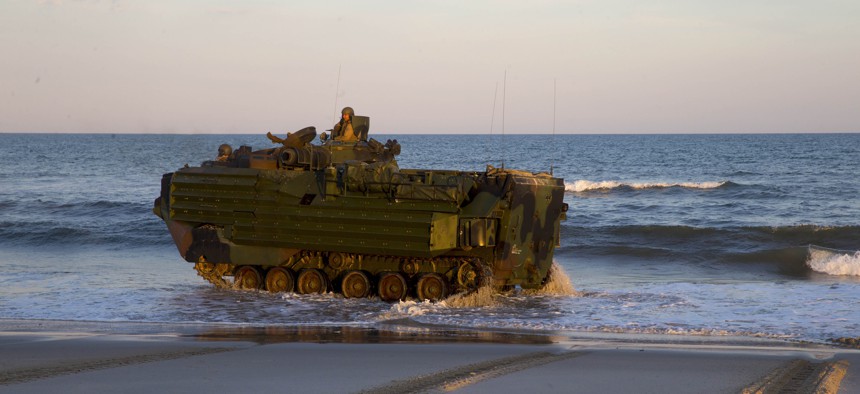
Marine Corps Lance Cpl. James Bastian and Cpl. Michael Lutz operate an assault amphibious vehicle during a ship-to-shore exercise at Camp Lejeune, N.C., June 26, 2020. U.S. Marine Corps / Lance Cpl. Jacqueline Parsons
Marines Remove AAVs From Deployment, Water Ops
The amphibious assault vehicle associated with the deadly 2020 sinking will no longer be used for deployments or offshore training.
The Marine Corps will stop operating its amphibious assault vehicles, known as AAVs, on scheduled deployments or or in the water, except as needed for crisis response, the service announced Wednesday.
The decision comes after investigations into the deadly July 2020 AAV accident in California revealed a litany of training and maintenance failures, along with leadership and accountability problems. The training accident off the coast of Camp Pendleton, California, killed eight Marines and a sailor.
Though the Marines believe “the AAV is a safe and effective vehicle for amphibious operations” when operated as recommended by the investigators, Commandant Gen. David Berger “has decided the AAV will no longer serve as part of regularly scheduled deployments or train in the water during military exercises,” spokesman Maj. Jim Stenger said in an email statement.
“AAVs will only return to operating in the water if needed for crisis response,” Stenger said, adding that the decision “was made in the interest of the long-term health of the amphibious vehicle programs and future capabilities.”
The vehicles will continue to operate on land, where three-quarters of its tasks are located, Stenger said. That will also allow the service to return the vehicles to the water later if necessary.
The Marine Corps was already working to replace the AAV with a new vehicle, called the Amphibious Combat Vehicle, or ACV, but that effort has not been smooth sailing. The service in September suspended waterborne operations for the ACV after a problem with the towing mechanism was identified. The Marines expect to fix that issue and return the ACVs to the water “early in the New Year,” Stenger said.




